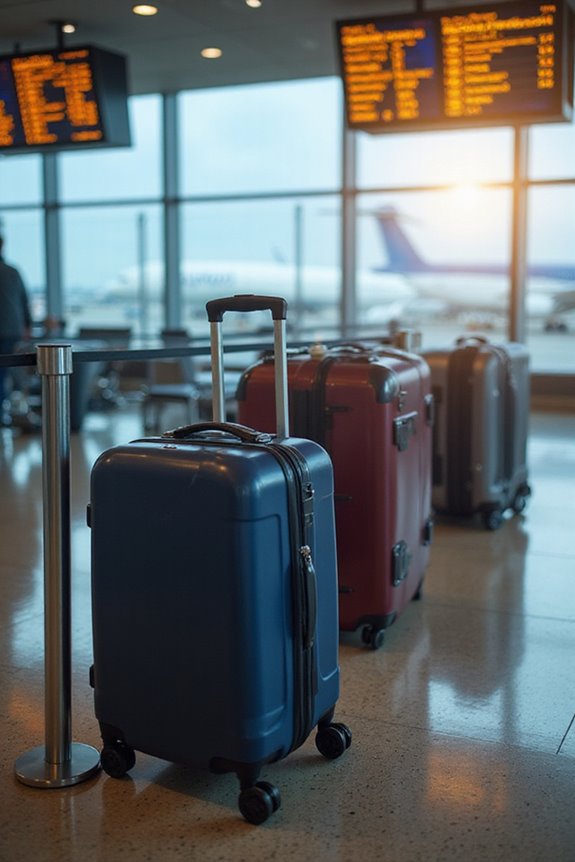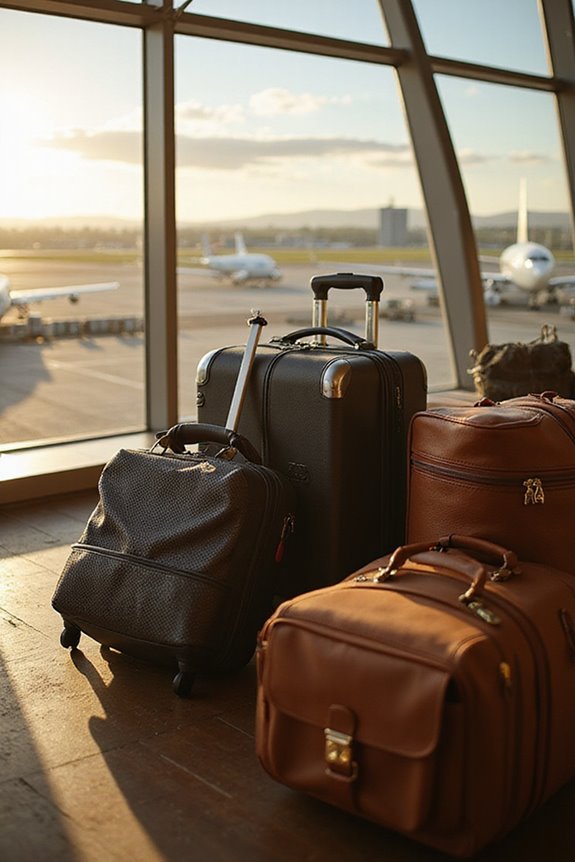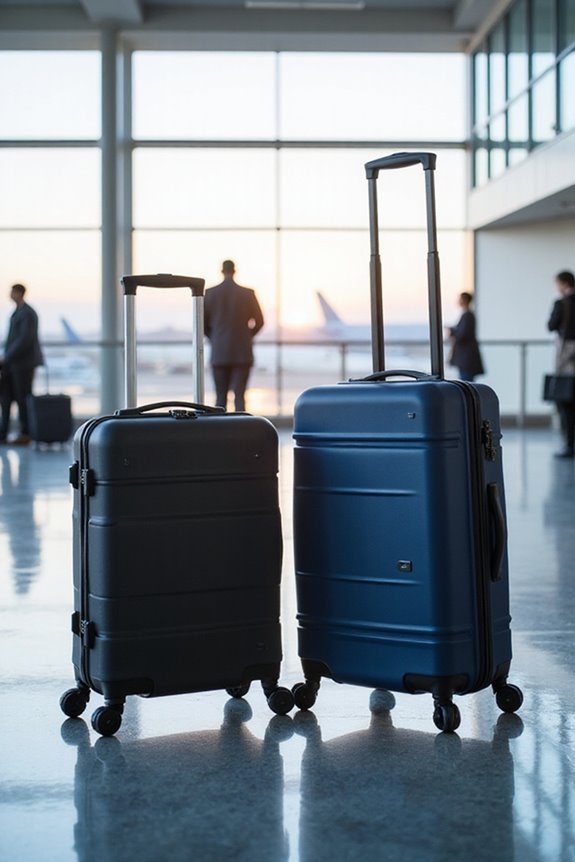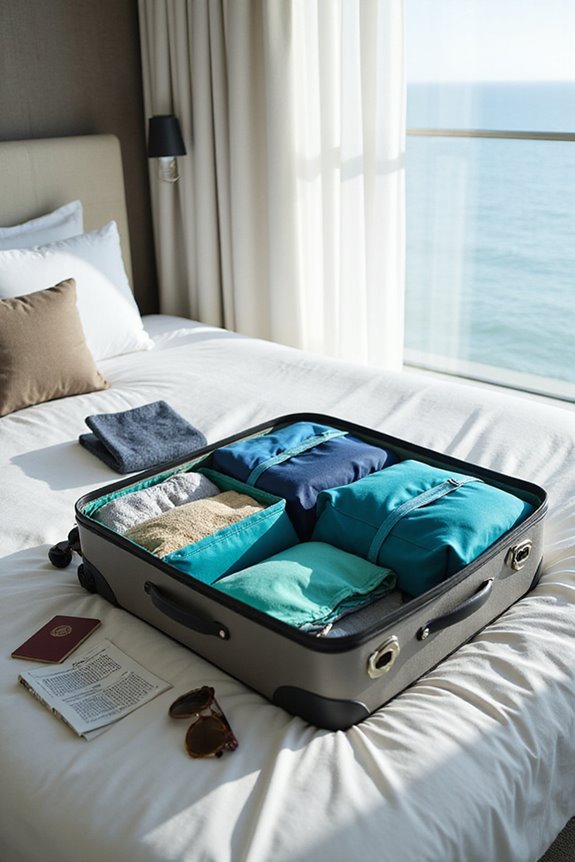Absolutely, wheels are included in luggage size measurements! I learned this the hard way when I almost got hit with extra fees at check-in because I forgot to measure my suitcase properly. When you measure, make sure to account for those wheels and handles—trust me, they can add vital inches. So, it’s super smart to double-check your dimensions against airline policies, or you might find yourself scrambling at the gate. There’s more to this than just measuring, so stick around!
Key Takeaways
- Yes, wheels are included in the overall dimensions when measuring luggage for airline compliance.
- Airlines sum up the height, width, and depth, accounting for wheels and handles.
- Ignoring wheels may result in inaccurate measurements and potential extra fees at check-in.
- It’s essential to measure from the bottom of the wheels to the highest point of the luggage.
- Always double-check airline policies to ensure compliance with their luggage size regulations.
Understanding Luggage Measurement Standards
When it comes to understanding luggage measurement standards, you might feel a bit overwhelmed, especially with all the varying rules from different airlines. Trust me, I’ve been there! It’s not just about the size; it’s about the luggage shape, too. For instance, each airline often sums up length, width, and height, which can get tricky. And don’t forget about those wheels and handles—they count! I once got caught off guard when my carry-on measured a bit too tall with the handle extended. Oops! Accuracy in measurement is essential; otherwise, you could face extra fees at check-in. So before you jet off, take a moment to measure your bags carefully, including every little protrusion. It’s worth it!
How to Measure Your Luggage Correctly
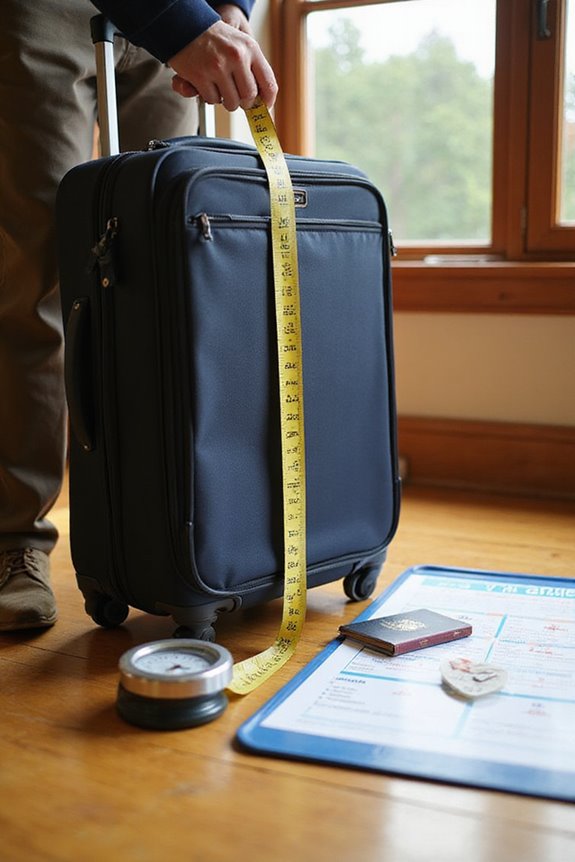
You might think measuring your luggage is as simple as grabbing a tape measure and calling it a day, but trust me, it’s a bit more nuanced than that. First, I place my suitcase upright, handle collapsed. Using my trusty measuring tape, I measure height from the base (including those pesky wheels) to the highest point. Next, I measure width across the widest part, including any pockets. Then I lay it flat for depth, capturing any expandable sections. I make sure to record all these measurements for accurate dimension recording. Additionally, it’s essential to consider the carry-on regulations set by airlines, as they can vary significantly and affect your travel plans. Oh, and don’t forget to round up! Airlines can be sticklers for size limits, and you don’t want surprises at check-in. Trust me, it’s worth the effort!
The Role of Wheels in Luggage Dimensions
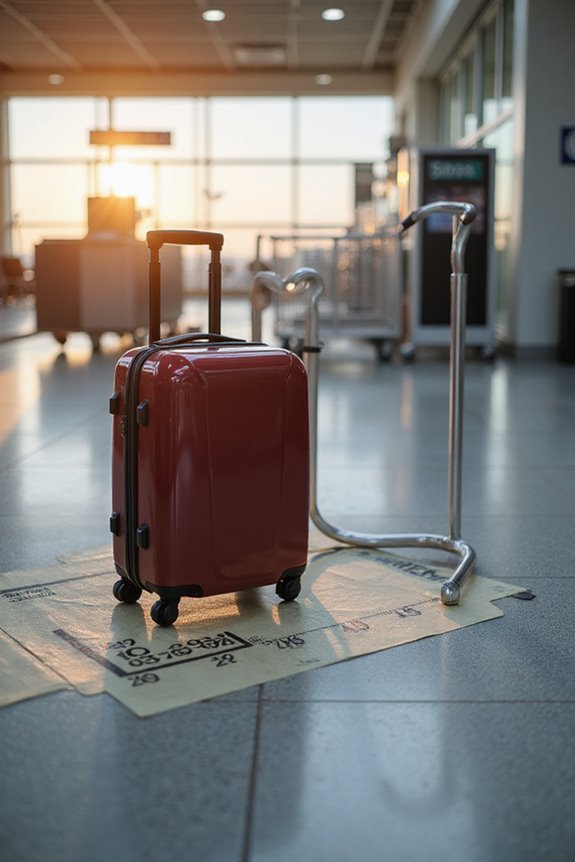
Wheels play a surprisingly essential role in how we measure our luggage—who knew, right? When I first started traveling, I didn’t realize that those little wheel types could change everything! Luggage styles vary, but whether you’ve got a hard shell or softside bag, those wheels add to the height and length. Airlines measure from the top of the suitcase, including the wheels, so it’s vital to take them into account. Trust me, missing this detail can lead to hefty oversize fees at check-in. I learned the hard way! So, next time you’re packing, make sure to factor in those wheels. They’re not just for show; they’re part of the luggage equation, keeping your travels smooth and stress-free! Additionally, choosing lightweight options ensures that you can handle your luggage more easily, even with the added height from wheels.
Airline Policies on Luggage Size Regulations
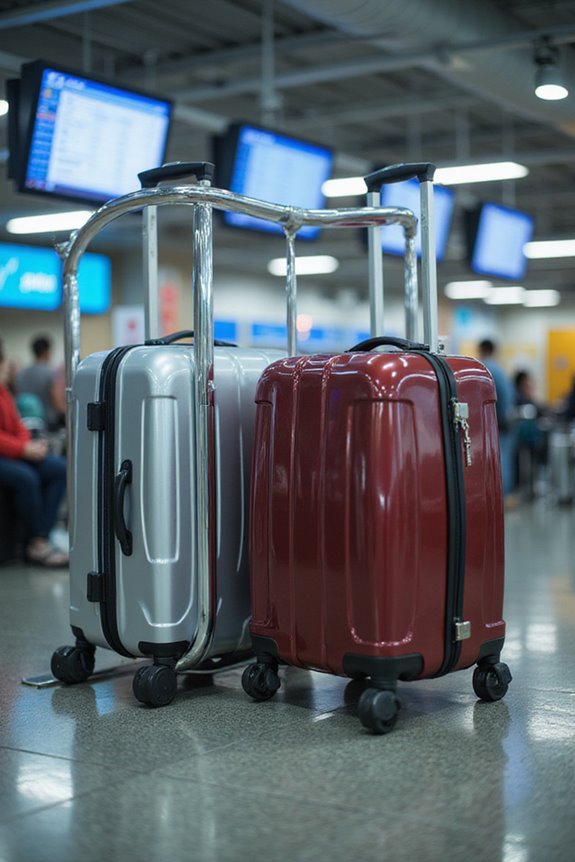
Maneuvering airline policies on luggage size regulations can feel a bit like trying to solve a Rubik’s Cube while blindfolded. Trust me, I’ve been there! Each airline has its quirks, especially when it comes to carry-on sizes. For instance, many U.S. domestic airlines stick to a standard of 22 x 14 x 9 inches, wheels included. But if you’re flying internationally, those limits might change, sometimes requiring you to squeeze into 21.5 x 15.5 x 9 inches. And don’t get me started on size enforcement! I’ve seen gate agents pull out their measuring tapes like they’re conducting a science experiment. The takeaway? Always double-check your airline baggage policies before you pack, or you might find yourself checking that bag at the gate! Additionally, optimal carry-on luggage typically weighs between 5-8 pounds, which is crucial for meeting airline standards.
Manufacturer Guidelines for Measuring Luggage
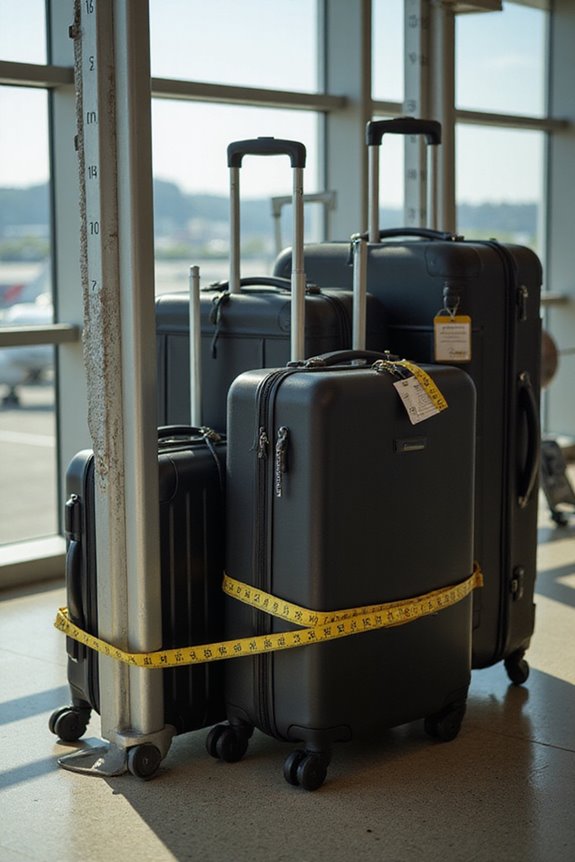
When it comes to measuring luggage, there are a few key guidelines that can save you from the clutches of airport drama. First off, remember those manufacturer measurement criteria—most brands want you to include wheels and handles when figuring out size. Seriously, skipping them could lead to a nasty surprise at check-in! I’ve learned the hard way that collapsing the handle for height measurement is essential. And don’t forget, dimensions are usually in centimeters or inches, depending on where you are flying. Also, using total outer dimensions helps align with luggage sizing standards and airline limits, making packing a breeze. Trust me, knowing these things can keep your travel experience smooth and stress-free!
Practical Tips for Travelers on Luggage Size
Packing for a trip can feel like a mini adventure, especially when you’re trying to navigate the tricky world of luggage size. I’ve learned that including wheels and handles in measurements is essential; they can sneak up on your carry-on limits! When choosing a bag, I always look for one that clearly states its exterior dimensions—trust me, it saves you from last-minute surprises. I also use packing strategies like rolling clothes to maximize space and keep luggage weight in check. And don’t forget to re-measure after packing! I once had a bag that seemed fine until I realized it was a tad too deep. That lesson was costly! So, keep it light, organized, and compliant for a smooth journey. Additionally, selecting a suitcase with four multi-directional spinner wheels can significantly enhance your mobility through crowded airports.
Common Mistakes in Measuring Luggage
It’s easy to overlook some common mistakes when measuring luggage, especially if you’re in a rush or just excited about your upcoming trip. I can’t tell you how many times I’ve almost messed it up! One big blunder is ignoring wheels and handles; they count towards your total size. If you forget to measure those protruding parts, you might end up with a surprise at the airport. Also, some luggage shapes can trick you—softside bags can expand, changing their size. And don’t get me started on linear inches; forgetting to add all dimensions together can lead to major measurement errors. By double-checking these details, you can avoid unexpected fees and enjoy your journey!
Variations in Airline Size Policies
Ever wondered why packing for a flight can feel like trying to solve a puzzle? It’s because of the carry-on confusion from airline size policies! Most U.S. airlines allow bags up to about 22 x 14 x 9 inches, but international carriers? They throw in a twist. Take Air China, for instance, which allows slightly different dimensions. I’ve had my fair share of surprises at check-in when I realized my bag didn’t meet the size limit. It’s frustrating! Plus, regional discrepancies mean that one airline’s rules can completely clash with another’s. So, always check specific policies before your trip. A little preparation can save you from fees or worse—being denied boarding. Trust me, don’t leave it to chance!
The Impact of Wheel Size on Luggage Compliance
When you’re rushing through the airport, the last thing you want is to be caught off guard by your luggage’s size, especially because of those pesky wheels. Trust me, I’ve learned this the hard way. Those wheels can add up! A larger wheel diameter means extra inches, which could tip your bag into oversize territory. I’ve seen friends struggle at check-in, facing fees just because their luggage weight and dimensions included those chunky wheels. It’s essential to measure from the bottom of the wheels to the top of the handle to avoid surprises. So, before you head out, take a moment to check that wheel size—your wallet will thank you later, and you won’t have to endure the embarrassment of repacking! Additionally, suitcase sizes vary significantly, so understanding the full dimensions is crucial for compliance with airline regulations.
Recommendations for Choosing the Right Luggage
Choosing the right luggage can feel like maneuvering through a maze, especially with so many options out there. I remember the first time I faced this dilemma; I was overwhelmed! You’ve got to take into account your travel needs and the different luggage types available. For short trips, a compact carry-on is a lifesaver—no check-in lines! For longer journeys, a checked bag is essential, but make sure it meets those pesky size limits. Trust me, lightweight options are your best friends to avoid those annoying extra fees. Look for spinner wheels for easy navigation and sturdy materials that won’t give up after a few flights. Additionally, consider weight considerations to ensure you’re not weighed down by your luggage. Ultimately, pick something that reflects your style and fits your adventures. Happy travels!
Frequently Asked Questions
Do Different Airlines Have Varying Rules About Luggage Wheel Measurements?
I’ve noticed that airline policies on luggage dimensions often vary, but generally, they include wheels in the measurements. It’s essential to check each airline’s specific rules to avoid surprises during travel.
How Do Oversized Wheels Affect Luggage Size Compliance?
When I bought my new suitcase, those oversized wheels felt like giving me extra horsepower. But, they actually shrank my luggage efficiency. Wheel design matters; it can make or break compliance with airline size limits.
Can I Detach Wheels to Meet Size Requirements?
I wouldn’t recommend wheel removal for luggage modifications. Airlines expect bags intact, and tampering can lead to issues at check-in. It’s better to choose luggage that fits size requirements instead of risking damage or denial.
Are There Exceptions for Specialized Luggage Types Regarding Wheels?
When it comes to specialized luggage, I’ve found that there aren’t exceptions regarding wheel design. Airlines consistently include wheels in size measurements, so I always choose larger options to avoid any packing surprises.
What Happens if My Luggage Exceeds Size Limits Due to Wheels?
If my luggage exceeds size limits due to wheels, I risk extra fees or having to check it instead. It’s essential to measure my bag’s dimensions carefully to comply with travel regulations and avoid surprises.

